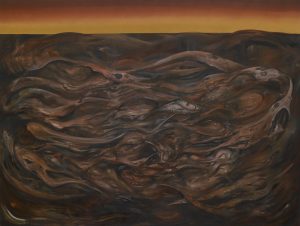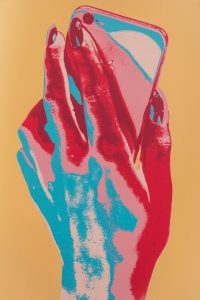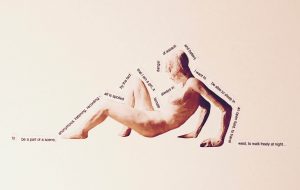Fine Art
The 2018 DJCAD Degree Show is the culmination of four years of hard work and dedication. The Fine Art course encompasses all forms of making from film to fabrications, painting to performance. This year is no different with a wide variety of techniques on display, ensuring a diverse viewing experience around every corner. Not a department to shy away from raising controversial issues, political statements run deep throughout these studios.
The unconscious is explored in the first room. Fuelled by the notion of ‘hell’ and the psychological landscapes we all tread through, Glenn Torkildsen’s dark oil paintings, which almost appear as if they are shifting or changing, draw you in. With the imposing scale of the sepia-toned paintings, Torkildensen manages to orchestrate a sense of unease and evoke the uncanny. In the same room, Caitlyn Vesey’s work tackles memory. We are brought into her grandfather’s greenhouse, all painstakingly reconstructed in the studio space; there is a scent of greenery and birdsong in the air. The love in the work is clear, and reminds me of my grandmother’s similar garden and her love of nature.
Minimalist, yet powerful, Ewa Piotrawska-Baxter’s emotionally-charged work resides in the next studio. The scent of intense herbal concoctions and soap fills the air, almost making my eyes water. Her work tackles the subject of abortion laws in Poland with grace and control; it is one of the harder-hitting pieces on display this year. ‘Forgive the father for I have sinned’ is emblazoned across the wall and an aspersorium filled with holy water lies below. The rest of the aspersoria in the room are filled with potent solutions used by women to induce a miscarriage.
By contrast the next studio space contains vibrant and bold work that demands your attention. Agata Urbanska’s screenprints question our addiction to social media and the internet. Created with high contrast and saturation, they speak about our need to be constantly connected to everyone and everything. Following a similar vein, Kristina Pelehacs’ paintings are colourful and humorous, playing with the concept of internet memes. Bright paintings cover the walls with amusing statements, providing some light comic relief from heavy themes.
Strong colour is a predominant theme running through these studios, and is best seen in Sobia Ashraf’s multi-sensory work. The viewer is greeted with a wall of bright, golden turmeric which has been used as paint. Underfoot are rice grains which echo a pleasing crunch. The work relates to Ashraf’s Pakistani culture and, specifically, her relationship to her mother. The space is cosy and inviting; this is a deeply healing exhibit.
In the same room you can see the work of Beth Brawley. Bold collages of magazines and newspaper headlines adorn the walls. She plays with parts and pieces — picking up and sewing back together — and explores feminist politics, not stridently but as a quietly powerful statement about how women are viewed in society.
A short walk away lies the art of Reece Arshad. His highly minimalist yet impactful work deals with nature and its relationship to structures created by mankind. His intelligent use of scale, proportion and form informs every piece on an individual level. Concrete and bronze are worked with so effortlessly they look like malleable clay, while balance and juxtaposition are used in perfect harmony.
This year’s degree show is not to be missed.




Leave a Reply